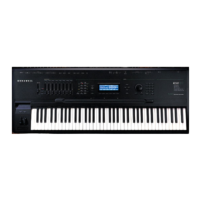Global Mode
Main 2 Page
6-6
Velocity Map
e Velocity Map parameter determines the way the PC4 SE generates MIDI velocity
information. Dierent maps generate dierent MIDI velocity values for the same physical
key strike velocity.
e default map (Linear) provides the widest range of velocity expression, but you may want
to choose a dierent map if the default does not suit your playing style. You can select from
any of the following settings:
Light3
Light2
Light1
Makes it increasingly easier to produce high MIDI velocity values for the
same key strike velocity (with Light3 being the easiest). These maps work
best for those with a light touch.
Linear
The PC4 SE default map. Linear, allows MIDI velocities to pass unchanged.
It follows a linear response.
Hard1
Hard2
Hard3
Makes it increasingly harder to produce high MIDI velocity values for the
same key strike velocity (with Hard3 being the hardest). These maps work
best for those with a heavy touch.
PianoTouch
Simulates the general velocity response of an acoustic piano, and is best
suited for playing acoustic piano programs.
Easy Touch
Similar to the Light1/Light2/Light3 settings. Makes higher velocities easier
to play, but allows more sensitive control over playing high velocities by not
boosting the MIDI velocity for fast strike velocities as much as it does for
medium strike velocities.
GM Receive
Mimics the velocity response commonly used by keyboards that use the
General MIDI (GM) sound set. The GM Receive map makes medium strike
velocities produce higher MIDI velocities compared to the Linear map.
Intonation Map
Most modern western music uses what is known as equal temperament. is means that
the interval between each semitone of the 12 tone octave is precisely the same as every other
semitone.
However, many dierent intonation intervals have evolved over the centuries and across
cultures and instruments, so equal temperament will not sound appropriate for certain styles
of music. e PC4 SE supplies you with 18 dierent factory intonation maps which are
useful for a range of dierent styles. Each of these maps denes dierent intervals between
each of the semitones in a single octave (used for all octaves) by setting pitch osets for each
note in cents.

